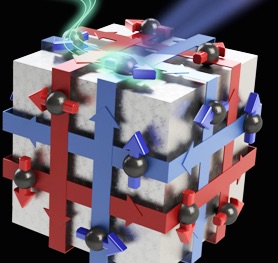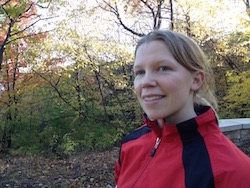Last month David Thouless, Duncan Haldane and Michael Kosterlitz were awarded the 2016 Nobel Prize in Physics for their work using mathematical methods from topology to understand strange phenomenon in phases of matter and phase transitions. In the first and previous articles we explored their work. In this article, we ask mathematical physicist Fiona Burnell, from the University of Minnesota, about her own work with topological materials and how they might play a part in creating quantum computers.
Interesting on the outside
One of the characteristics of topological materials is that unexpected properties emerge at their ends (the Haldane phase of chains of atomic magnets) and edges (topological fluids such as those in the quantum Hall effect). This emergent behaviour is the focus for some of Burnell's recent work.
Physicists often work with simplified toy universes, and Burnell is interested in ones which have no particles with half-integer spin (you can think of spin as the angular momentum of the particle). In such universes these forbidden particles can appear at the ends of one of these Haldane phase chains. And these ideas can be extended to higher dimensions: "You can construct systems that are boring in the bulk, look no different, say, to the boring chain, but at the surface is something you couldn't construct, something that is fundamentally impossible."

A topological insulator conducts electricity on its surface, but not in its interior. Moreover, the direction of the spin of the electron's on the surface is tied to the direction of the current.
A direct result of the work of Thouless, Haldane and Kosterlitz is the prediction and experimental observation of exciting new topological materials. In 2006 several groups of mathematical physicists independently predicted the existence of a new type of insulator called a topological insulator. These new materials have surprising properties: while the interior looks like the ordinary band insulator, the surfaces conduct electricity. These surface states are also incredibly robust: it doesn't matter where or how you cut the material, the resulting surface will always be conductive. Moreover, unlike ordinary metals whose surfaces lose conductivity as they oxidise or corrode, the surface of a topological insulator will always conduct electricity, even in the presence of impurities and defects.
This is because the conductive states at the surface of these materials are topologically protected. Just as for the other materials discussed before, we are not concerned with the shape of the physical material but instead the shapes of the mathematical forms that describe the states of the electrons. In an ordinary band insulator you can transform the mathematical description of the electron states to one that essentially ties each electron to a specific atom. However you cannot do this for the mathematical descriptions of the electron states for a topological insulator. "Basically, the wave function of the electrons is topologically non-trivial," says Burnell. "You can think of it as having a sort-of 'winding' (not exactly winding, but that gives the right intuition) which prevents you from being able to smoothly deform the electronic state to one in which the electrons are bound to individual atoms. It is the difference between this kind of bulk and the bulk of an ordinary insulator that produces [the conductive states on the surface]."
Once people knew what to look for, they rapidly were able to make materials with the desired properties. Without the theoretical understanding of what those properties were (i.e. what to measure in experiments to see that you had a topological insulator) and why they arose (i.e. what kinds of materials would behave in this way) it is very unlikely that these properties would have been discovered experimentally.

The way things are now
freeimages.co.uk
The shape of things to come
The novel properties of topological materials also promise to revolutionise electronics. Over the decades electronic components have shrunk in size, enabling them to run at faster and faster speeds. However there is a limit to how far this miniaturisation can go: the electric current passing through these components generates heat and they must be of a certain minimum size in order to dissipate that heat energy. Spin currents, however, which transfer the spin state of an electron rather than its electric charge, do not produce heat. Spintronics, electronics based on these spin currents, should lead to decreased chip size and hence faster computer processors.
Topological insulators are an ideal material to build such spintronic components. On the surface of these materials the spin of an electron is coupled to its electric charge: the direction of the spin of the electrons is always perpendicular to the direction of the electric current. This property allows the manipulation of spin currents and these materials should form part of the first functioning spintronic components.
These materials may also be the key to building quantum computers. "Quantum computing seeks to replace conventional transistors with quantum gates," says Burnell. "These actually process information in a different way than conventional transistors, and could in principle do some kinds of computations much more quickly than current computers." But one of the greatest challenges is isolating a system so that it can maintain a particular quantum state. "If you arrange the system in a certain way and leave it - will it stay that way?" says Burnell. "It's like [having] a kindergarten class of 30 kids and putting them in one room and hoping they stay that way – chaos will break loose and toys and children will be all over the floor." Burnell, together with Steve Simon at the University of Oxford, have been studying materials (or mathematical models they hope will describe the behaviour of materials) that have topological properties which could be harnessed to create a quantum computer. "Right now one of the major challenges in the field is to find systems that people can actually make that would have the necessary properties, and that has been one of my ongoing interests."
For Burnell, the rise of topological materials is a good example of the impact mathematical understanding can have on physics. "It's an illustration of what will happen more in condensed matter physics. It's been a long time since someone walked out of a lab with something unexpected. Materials are complicated and increasingly the space of possibilities is so large. Guidance from mathematical physics is helpful in identifying what region is the most interesting to look at."
About this article

Fiona Burnell
Fiona Burnell is currently an assistant professor of physics at the University of Minnesota, where she researches the theory of quantum materials, with a particular interest in understanding how symmetry and topology shape the types of behaviours these can have. Before joining the faculty at Minnesota she was a post-doctoral fellow at All Souls college in Oxford.
Rachel Thomas is Editor of Plus. She interviewed Burnell in October 2016, and also in July 2013 for the booklet, Mathematical physics: what is it and why do we need it? produced for the Institute of Physics. This final article is based on part of that booklet. You can download a copy for yourself to find out more about the fascinating world of mathematical physics!